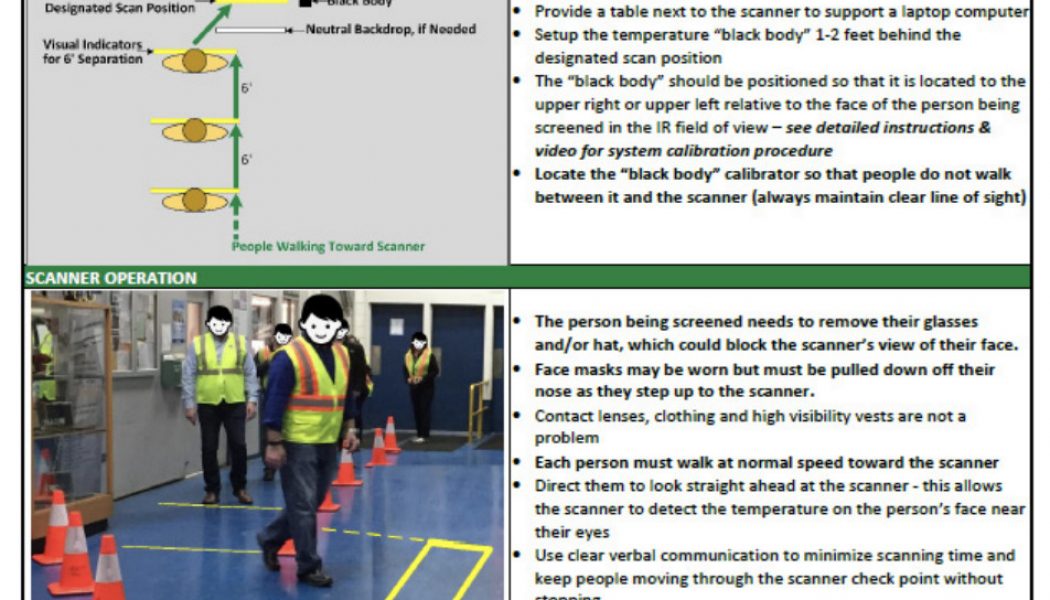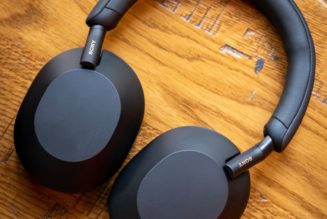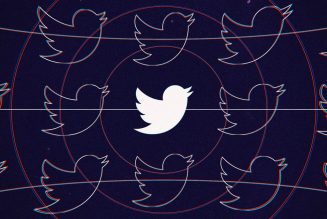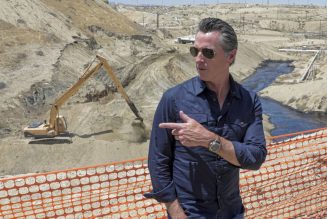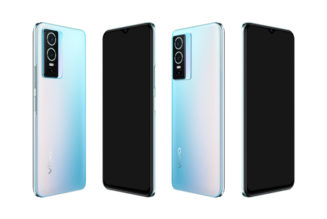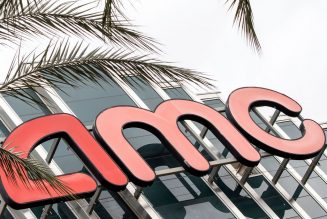In the last week, factory employees have returned to work across the United States to make cars for the country’s four main auto manufacturers: Ford, General Motors, Fiat Chrysler Automobiles, and Tesla. And each of those companies has published a plan showing how it will try to keep those workers from contracting or spreading COVID-19.
Those plans largely take the same shape. They’re presented in glossy PDF pamphlets, each starting with a letter to employees from the respective company’s highest-ranking executive overseeing workplace safety. Like any corporate document, they occasionally get bogged down with platitudes. But they all largely describe a lot of the same basic precautions, including supplying employees with Personal Protective Equipment (PPE) like masks or enforcing physical distancing of at least six feet.
There are some differences between them, though. And none have robust in-house testing plans in place, despite the United Auto Workers union (which represents the workers in all of the factories, save for Tesla’s) agitating for it. So as each company inevitably starts dealing with infected employees — as Ford already has this week at its Chicago assembly plant — it’s worth understanding what’s in the plans and where they diverge.
Ford operates eight US factories across its main brand and its luxury marque, Lincoln. At 64 pages, Ford’s is the longest of the return-to-work plans released by these four automakers. No surprise. Chairman Bill Ford said the company “put as much care and attention into developing our plan to return to work as anything I’ve been involved in in my 40 years of work.”
Some of the playbook’s length is the result of Ford’s inclusion of sample checklists for managers and factory cleaning teams and also from the company’s willingness to repeat itself to hammer home the main points of the plan. Ford even fills a few pages with puffy corporate speak (like on page 4, where it describes one of its company “truths” as the ability to “meet our business challenges head on by being relentless in creating value for our customers and optimizing our fitness.”)
.@Ford Executive Chairman Bill Ford:
“We put as much care and attention into developing our plan to return to work as anything I’ve been involved in in my 40 years of work.” pic.twitter.com/l4YAJNo13B
— Michael Martinez (@MikeMartinez_AN) May 21, 2020
But the company also takes a handful of pages to lay out its temperature-screening protocol for workers who are entering the factory each day, which is arguably the most involved setup of any of these four automakers. Ford employees are required to stand in front of an infrared scanner on a tripod as they make their way into the workplace. They have to remove glasses and hats and must pull down face masks in order to get an accurate reading, all while following markers on the floor and looking directly into the scanner.
If an employee shows a temperature above the threshold Ford has set (which is not disclosed), they have to do one of three things before they can return to work. They can show that their health care provider has “determined clinically” that they don’t have COVID-19. They can return if they have no fever for 72 hours and 10 days have passed since their symptoms appear. Or they can return if they no longer have symptoms and have received two negative test results in a row and at least 24 hours apart.
Not having a testing regime in place means there are holes in plans even as detailed as this — and the same goes for the other automakers’ plans — because people can have and spread the coronavirus without showing any symptoms. For instance, If a health care provider decides a Ford employee’s symptoms were related to another illness, that would clear them to return. But it doesn’t mean that employee isn’t carrying the coronavirus.
Ford is making all employees complete an online survey each day “assessing their ability to report to work.” They’re required to show an email or SMS confirmation that they filled out the survey when they arrive for their shift.
And Ford describes a number of other precautions it’s taking to mitigate any spread of the coronavirus inside its factories. It’s essentially slicing those factories up by both assigning employees to the entrances and parking lots closest to their work stations. The company is also restricting those employees to using the bathrooms closest to them — even if it’s not the one they normally use.
:no_upscale()/cdn.vox-cdn.com/uploads/chorus_asset/file/19994084/Screen_Shot_2020_05_22_at_11.02.28_AM.png)
Ford is spreading out those workstations to six feet or more where possible. Where that isn’t possible, the company is putting in plastic barriers or shields. Workers are being given new masks each day as well as fresh safety glasses, and some will receive full face shields. All visitors, contractors, and vendors are being required to wear masks as well — unless you’re President Trump, who was not forced to wear a mask during his entire visit on Thursday. (He was only “encouraged,” according to a statement from Bill Ford.) The company is requiring that all of its factories keep a minimum 30-day supply of PPE (including surgical gloves, safety glasses and face shields, and disinfectant spray and wipes).
Ford has also asked factory managers to stagger workers’ shift start times where possible and is closing common areas like small meeting rooms and fitness and physiotherapy centers. Cafeterias will be closed, too, and Ford is encouraging conference calls and Webex meetings over face-to-face interactions.
Despite all of this, Ford has had three employees test positive for COVID-19 this week. In the company’s published plan, it explains the steps that it’s taking when this happens. First, Ford’s human resources department is supposed to perform contact tracing to figure out who else may have been exposed. Workers who’ve had “close contact” — defined as being within six feet of an infected employee for more than 15 minutes or having “direct contact with infectious secretions” from one — will be sent home for 14 days. The company will either temporarily close that worker’s area of the factory or the whole facility to clean.
Working during a pandemic is stressful, and Ford reminds its employees that they “are not alone” if they find themselves worrying about their mental health. As such, Ford tells employees in the playbook that they should limit “news consumption, including social media,” and to “manage” their technology by turning off “distracting notifications.” The company suggests workers “[u]nwind with music or a podcast,” “try a new recipe,” or learn “a new skill.”
“Don’t forget to laugh!” Ford writes.
What Ford’s plan lacks is a clear strategy for testing its employees. That work is instead left to the employees themselves and their health care providers. Unfortunately, the company is not alone.
General Motors’ 40-page plan is the second-longest of the four. Much like Ford’s, GM’s guide covers protocol for temperature screenings, cleaning, and physical distancing, but it offers no plan for testing its workers.
GM — which operates 10 factories in the US across its Buick, Cadillac, Chevrolet, and GMC brands — is using a similar temperature screening process to Ford’s. Instead of a scanner on a tripod, though, GM appears to be using a handled infrared scanner. Instead of making workers fill out a questionnaire online before coming to work, GM is asking them questions as they arrive for their shift.
Once they arrive, workers are given and are required to wear a face mask except for when eating or drinking. Employees are not allowed to use “[h]omemade or externally-purchased masks” because the company says it can’t “verify the adequacy of the design or materials,” though it will allow the use of N95 respirators in certain cases. GM is allowing employees to reuse their masks, though it advises them to store it in a “lunch-size paper bag” to both allow it to dry out and keep it away from potential contaminants.
Inside GM’s factories the company is asking that doors be propped open to increase airflow and reduce the number of surfaces workers need to touch. GM also recommends that workers use body parts other than their hands to open doors when they can. Employees are being spaced out beyond six feet where possible, though there’s no mention of the use of plastic dividers or shields. Where employees must work closely together, GM says “wearing a face mask and safety glasses provides the necessary protection.”
:no_upscale()/cdn.vox-cdn.com/uploads/chorus_asset/file/19994079/Screen_Shot_2020_05_22_at_11.01.04_AM.png)
If an employee feels symptomatic at home, GM asks that they take their own temperature before they come in. If it’s above 100.4 degrees Fahrenheit, GM asks that they don’t come to work and instead contact their physician. GM is telling employees who feel symptomatic at work (or people who encounter someone who’s symptomatic at work) to contact their supervisor and report “immediately” to their factory’s health center or call one of two provided hotlines.
Employees who test positive for COVID-19 are being asked to contact their supervisors and call one of those hotlines. GM will perform contact tracing to determine who else may have contracted the virus. The company does not go into further detail in its return-to-work plan about how it will handle positive cases. Like Ford, GM also recommends that employees “[a]void binging on the news, social media and television,” get good sleep, eat healthy, and avoid alcohol and drugs.
Fiat Chrysler Automobiles (FCA) — which runs six US factories under its Chrysler, Dodge, Jeep, and RAM brands — published a much shorter 11-page return-to-work “packet” that covers some of the same bases as Ford’s or GM’s. But FCA’s plan deviates on how the company is taking temperatures and is generally more limited in its scope and detail.
Instead of using digital temperature scanners, FCA is providing all employees with a “reusable temperature strip.” The company says its factory workers have to take their temperatures with either this strip or their own thermometer less than two hours before each shift. Workers using the temperature strip have to hold it up to their foreheads and hold it in place for about 15 seconds. Their foreheads must be “dry,” FCA says, and the strip should only be used “indoors at room temperature” away from sunlight or “strong lamps,” and at least 30 minutes after eating, drinking, exercising, or being outdoors. The strip is reusable for 30 days.
FCA employees must then record that temperature on a “Daily Health Risk Assessment” sheet that must be filled out before each shift. If a worker’s temperature is 100.4 degrees Fahrenheit or higher (or they answer “yes” to any of the other questions on the sheet), they’re told not to go to work and must call a company hotline. While the plan doesn’t mention this, FCA said in a press release that it is “installing thermal imaging cameras to verify what employees and visitors have self-reported” about their temperatures.
:no_upscale()/cdn.vox-cdn.com/uploads/chorus_asset/file/19994074/Screen_Shot_2020_05_22_at_10.59.23_AM.png)
Upon arrival to work, FCA’s factory workers have to go through turnstiles where they hand in the completed risk assessment sheet. FCA asks that workers do not engage in “small talk” or ask questions at this point “so as to keep the flow of employees moving.” The company tells employees to use their forearm to push through the turnstile and offers hand sanitizer immediately after. They’re then given their daily surgical mask. (Personal masks are not allowed.)
FCA says it has implemented a “start-of-shift sanitation process” for each factory workstation and has increased the frequency of cleaning at its facilities. The company has suspended meetings of more than eight employees and has redesigned some areas to afford more distance. The plan does not go into detail about how it has altered those workstations, but images on its press website show how some areas now have plastic shields in place.
The automaker’s published return-to-work guide does not include any plan for testing employees.
Tesla’s playbook clocks in at 38 pages and helps illustrate why CEO Elon Musk was so vociferous about his desire to reopen the company’s vehicle factory in Fremont, California. Tesla dealt with a COVID-19-related shutdown at its China factory earlier this year, which has been back up and running for months, and so the company believes it knows what needs to be done to safely bring workers back to the Fremont plant — knowledge that informs Tesla’s playbook.
That said, Tesla’s playbook covers a lot of the same ground as the other automakers and likewise lacks a testing plan.
Tesla has increased the cleaning and disinfecting at its Fremont factory, and the company says it’s enforcing social distancing, adding barriers, encouraging videoconferencing, and staggering work shifts to help separate workers. Some common areas are closed, and conference rooms are being capped at one-third capacity. The company has also reduced the capacity of the shuttles it runs to the factory, and increased the number of total shuttles.
Thermal cameras have been installed at some entrances to measure workers’ temperatures, and Tesla is making them complete an online health check each day, much like Ford. Tesla is providing masks, and workers are expected to wear them. But the company leaves room in the language of the playbook for masks to be optional in some locations.
:no_upscale()/cdn.vox-cdn.com/uploads/chorus_asset/file/19994091/Screen_Shot_2020_05_22_at_11.04.23_AM.png)
Tesla lays out a handful of scenarios to show how it will deal with suspected or positive cases of COVID-19. If a Tesla employee has symptoms of COVID-19 — or just does not feel well — managers are told in the playbook to direct that worker to go home and consult their medical provider. Employees who do not show symptoms but have been in contact with someone who tested positive are told the same and will be required to quarantine for 15 days.
Employees who have symptoms and have had direct contact with someone who tested positive (or with someone who is awaiting their own test results) must stay home for 10 days after getting sick and at least three days after recovery. But if these employees receive a negative test, they can return to work after not showing symptoms for 24 hours. Tesla isn’t requiring that possibly infected employees receive two negative tests, like Ford.
In the event of positive cases, Tesla will leverage its security team to perform contact tracing. The company explains in the playbook that it will also clean the area where that worker is stationed, but does not go into further detail.
Like Ford and GM, Tesla says “[h]earing about the pandemic repeatedly can cause undue stress,” so it recommends employees take breaks from “watching, reading, or listening to news stories, including social media.” The company encourages workers to eat well, avoid alcohol and drugs, connect with others, and make time “to unwind.”
Taken together, these plans illustrate how difficult it will be to get the auto industry in the US back up and running during a pandemic. Each company’s plan is different, and while some are arguably better in certain respects, none are airtight — as we’ve seen with Ford already dealing with positive cases. These four are also nowhere near the only automakers in the US. Toyota, Volkswagen, Daimler (the parent company of Mercedes-Benz), BMW, Nissan, Honda, Hyundai, Kia, Subaru, and Mazda all operate factories here as well.
Automakers also have to deal with two other problems as they restart production. One is that many of them are reliant on suppliers that are dealing with their own localized outbreaks. If the suppliers have to stay shut down or stop production again, it could force US automakers to halt manufacturing. In fact, it’s already happening with GM.
The other is that demand for new vehicles had fallen dramatically during the pandemic. So even if everything goes according to the plans that these automakers have laid out, there may be no one waiting to buy the cars their workers make.
